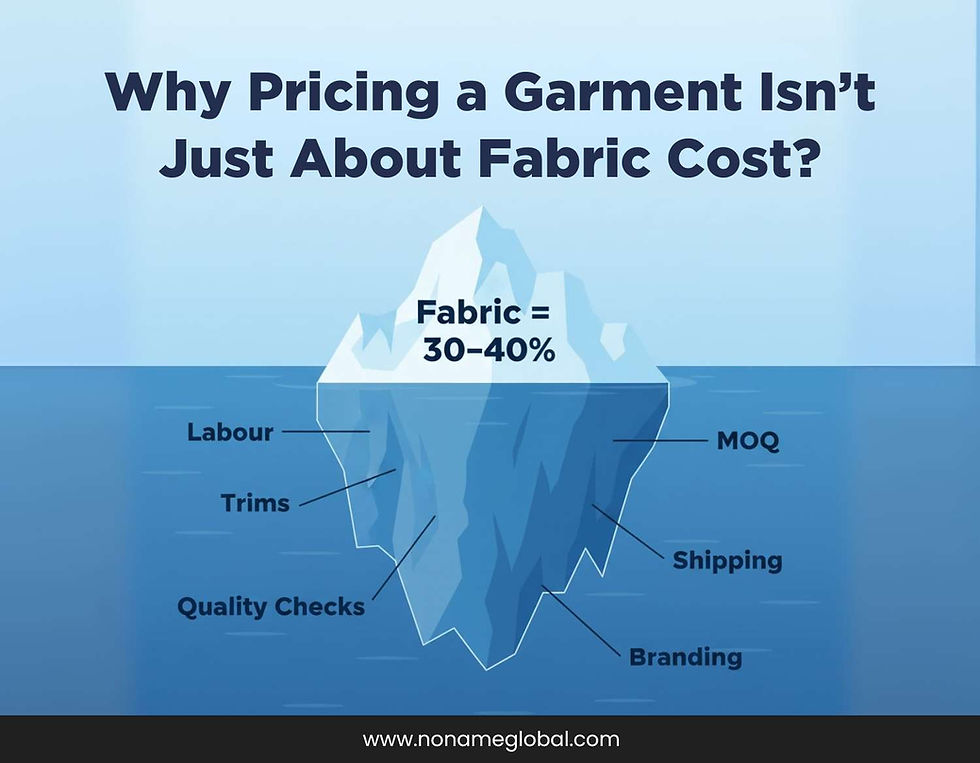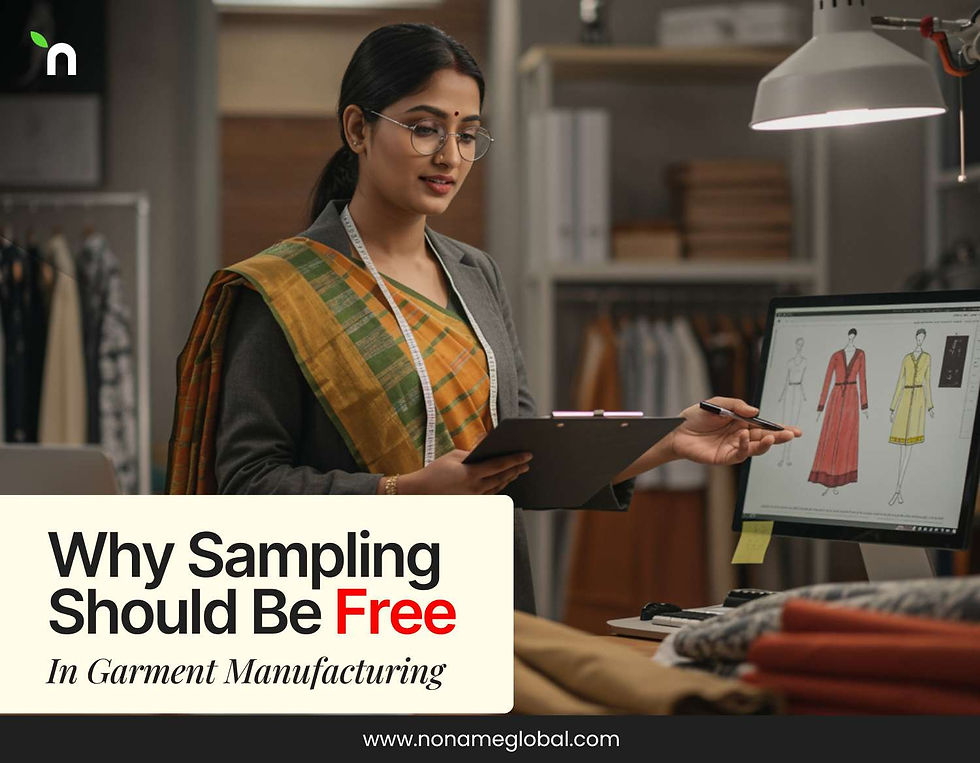Why Pricing a Garment Isn’t Just About Fabric Cost?
- Shraddha Srivastava
- Sep 30
- 5 min read
Summary:
Fabric is only 30–40% of the cost. The real price of a garment includes labor, trims, design, MOQ, quality checks, shipping, and brand value. If you're working with a garment manufacturer in India, understanding these costs helps you price smarter, earn better margins, and grow your fashion brand with confidence.

Introduction:
“Why is this dress so expensive? It’s just cotton!”
If you’ve heard this from a customer, or even thought it yourself, you’re not alone. But here’s the truth: pricing a garment is not just about the fabric. It’s a mix of many elements, from design to delivery.
If you’re a fashion retailer trying to set the right price for your products, you need to understand what really goes into the cost of making a garment. Knowing this will help you build a sustainable business, work better with your garment manufacturer in India, and confidently explain your prices to customers.
In this blog, we’ll break down the real cost of making a garment and explain why fabric is just one part of the pricing puzzle.

Why Pricing a Garment is a Complex Equation
Many retailers make the mistake of calculating their prices based only on fabric. But here’s a quick fact: fabric usually makes up just 30–40% of the total cost of a garment. The rest? It's hidden in plain sight, in the stitches, tags, packaging, people, and process.
Let’s look at all the other important factors that affect the pricing of a garment.
1. Labor and Manufacturing Costs
Garments don’t sew themselves. Whether it’s a simple T-shirt or a structured blazer, it takes trained workers to cut, stitch, press, finish, and pack the piece. And in India, labor accounts for 20–30% of the total garment cost, depending on complexity.
Complicated styles like pleated skirts, embroidered jackets, or layered dresses require more hours and skilled workers, which increases the cost.
Pro tip for retailers: Choose a cost-effective garment manufacturer in India who has a well-managed production process and ethical labor practices. This keeps your quality high and costs under control.
2. Trims, Accessories & Embellishments
That fancy zipper, satin lining, metal buttons, lace trim, or even the logo patch on the back all cost money. In fact, trims and embellishments can add 10–15% to the garment cost, especially for women’s and kids wear.
Even seemingly small items like hang tags and care labels cost money when you’re ordering in small batches.
3. Design and Development
Creating a garment isn’t just about sewing; it starts with an idea. This means sketching, making tech packs, pattern making, sampling, fitting, revisions, and more.
Retailers often forget that product development is a big part of pricing a garment. And if you want original, well-fitted clothes that your customers love, you must invest in this stage.
4. MOQ and Production Volume
MOQ (Minimum Order Quantity) plays a huge role in garment pricing. If you’re producing 50 pieces instead of 5,000, the cost per unit will be higher. Why?
Because the fixed costs (like setting up machines, cutting markers, quality checks, etc.) get divided over fewer garments.
That’s why startups or small brands usually pay more per piece, unless they work with a low-cost garment manufacturer in India who offers Flexi MOQ options.
5. Quality Control and Rework Costs
Maintaining consistent quality is not free. It requires inspections, skilled staff, and sometimes, rework. A single defective batch can lead to returns, brand damage, or even refunds.
So, when you factor in the cost of quality control, pricing a garment becomes more realistic and a little higher.
6. Overheads and Hidden Costs
Even if the factory is efficient, there are many “invisible” costs you can’t ignore:
Electricity
Rent
Water
Admin and management salaries
Machine maintenance
Compliance paperwork
Logistics and warehousing
These don’t directly show up in the garment, but they’re essential to getting it made.
According to a report by McKinsey, overhead costs can contribute to up to 20% of the total cost of a garment, especially in small-to-mid-scale operations.
7. Sustainable and Ethical Practices
If your brand stands for sustainability (and we hope it does!), then you’ll need to invest in:
Organic or recycled fabrics
Low-impact dyes
Fair wages
Waste management
All of these contribute to the true cost of pricing a garment. But customers today are more aware and willing to pay a little extra for ethically made clothing. According to a 2024 Statista report, 67% of consumers globally prefer sustainable fashion brands, especially in Europe and North America.
8. Shipping, Customs & Logistics
If you’re sourcing from a garment manufacturer in India, you also need to consider:
Freight or courier charges
Insurance
Customs clearance fees
Import duties (if exporting)
Inbound delivery costs (to your warehouse or retail store)
These logistical costs can account for 5–12% of the final garment price, depending on your shipping method and destination.
9. Brand Value and Positioning
Let’s say your cost to make a dress is ₹500. Should you sell it at ₹600? Probably not.
Pricing a garment also includes your brand story, marketing costs, and desired profit margin. If you’re building a premium brand, your pricing should reflect your quality and positioning.
Your markup should cover:
Website and photoshoots
Packaging
Influencer campaigns
Advertising
Staff salaries
Profits for growth
Remember, pricing isn’t just about what you pay; it’s about what your customers believe it’s worth.
The Most Cost-Effective Garment Manufacturer in India
If you're a fashion retailer looking to scale smartly, NoName is the ideal manufacturing partner.
As a leading garment manufacturer in India, NoName offers:
Cost-effective garment manufacturing with no compromise on quality
Low minimum order quantity (MOQ) options for startups and small brands
Expertise in woven, knitwear, streetwear, loungewear, kids wear, and sustainable fabrics
Ethical labor practices and sustainable production
Support with sampling, tech packs, and small-batch production
Whether you’re launching a new fashion brand or expanding your seasonal collection, NoName helps you balance quality and affordability, making it a low-cost garment manufacturer in India you can trust.
So, What’s the Right Way to Price a Garment?
There’s no single rule that works for everyone, but here’s a simple method that many fashion retailers use:
Total Garment Cost (including everything) × 2 or 2.5 = Wholesale Price Wholesale Price × 2 = Retail Price
This way, you have enough margin to cover your expenses, give discounts when needed, and still make a good profit.
Just remember, your total garment cost should include not just fabric, but also labor, trims, design, packaging, shipping, and other hidden costs we talked about earlier.
Conclusion: Look Beyond the Fabric
Next time you’re pricing a new collection, take a moment to look beyond just the fabric bill. Remember: pricing a garment is about more than just materials; it’s about people, processes, packaging, and positioning.
Knowing your true costs gives you confidence, improves profit margins, and helps you build a brand that lasts.
Looking for a cost-effective garment manufacturer in India?
NoName is your trusted partner for low-cost garment manufacturing without cutting corners. With flexible MOQs, transparent pricing, and a deep understanding of the fashion industry, we help fashion retailers like you grow with confidence.
Contact NoName today to discuss your next collection!
WhatsApp: +91-9717 508 508
Email: hello@nonameglobal.com
Website: www.nonameglobal.com
Online meeting: https://calendly.com/nonameglobal/meet














Comments